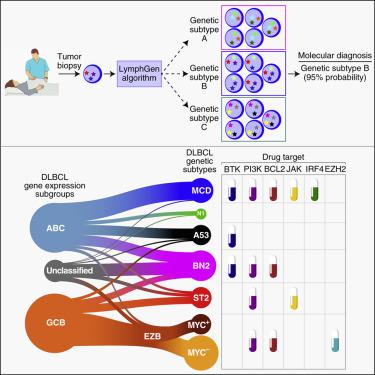Cancer Cell ( IF 48.8 ) Pub Date : 2020-04-13 , DOI: 10.1016/j.ccell.2020.03.015 George W Wright 1 , Da Wei Huang 2 , James D Phelan 2 , Zana A Coulibaly 2 , Sandrine Roulland 2 , Ryan M Young 2 , James Q Wang 2 , Roland Schmitz 2 , Ryan D Morin 3 , Jeffrey Tang 3 , Aixiang Jiang 3 , Aleksander Bagaev 4 , Olga Plotnikova 4 , Nikita Kotlov 4 , Calvin A Johnson 5 , Wyndham H Wilson 2 , David W Scott 6 , Louis M Staudt 2

|
The development of precision medicine approaches for diffuse large B cell lymphoma (DLBCL) is confounded by its pronounced genetic, phenotypic, and clinical heterogeneity. Recent multiplatform genomic studies revealed the existence of genetic subtypes of DLBCL using clustering methodologies. Here, we describe an algorithm that determines the probability that a patient's lymphoma belongs to one of seven genetic subtypes based on its genetic features. This classification reveals genetic similarities between these DLBCL subtypes and various indolent and extranodal lymphoma types, suggesting a shared pathogenesis. These genetic subtypes also have distinct gene expression profiles, immune microenvironments, and outcomes following immunochemotherapy. Functional analysis of genetic subtype models highlights distinct vulnerabilities to targeted therapy, supporting the use of this classification in precision medicine trials.
中文翻译:

具有治疗意义的弥漫性大 B 细胞淋巴瘤遗传亚型的概率分类工具。
弥漫性大 B 细胞淋巴瘤 (DLBCL) 精准医学方法的发展因其明显的遗传、表型和临床异质性而受到混淆。最近的多平台基因组研究使用聚类方法揭示了 DLBCL 遗传亚型的存在。在这里,我们描述了一种算法,该算法根据患者的遗传特征确定患者的淋巴瘤属于七种遗传亚型之一的概率。这种分类揭示了这些 DLBCL 亚型与各种惰性和结外淋巴瘤类型之间的遗传相似性,表明有共同的发病机制。这些遗传亚型还具有不同的基因表达谱、免疫微环境和免疫化疗后的结果。











































 京公网安备 11010802027423号
京公网安备 11010802027423号